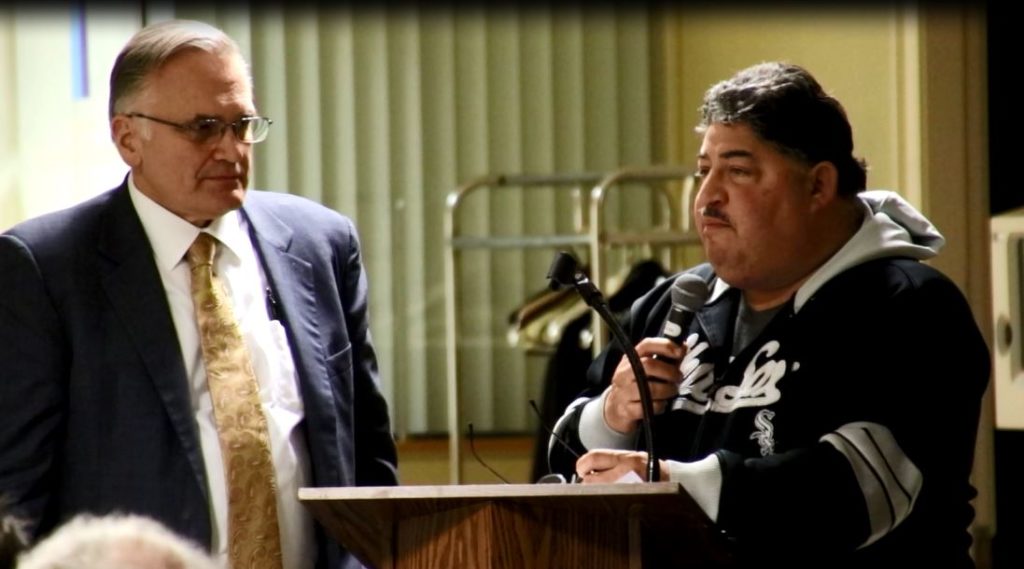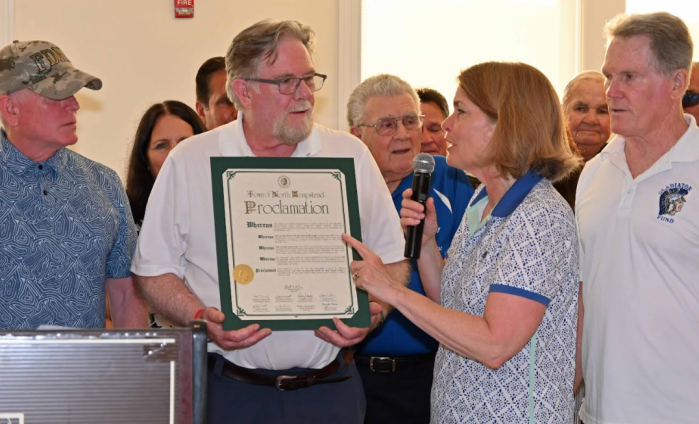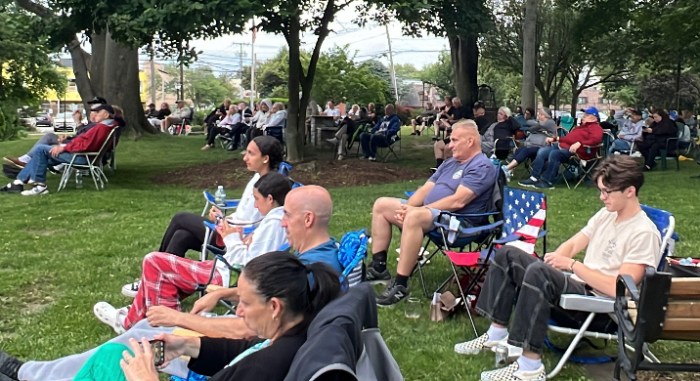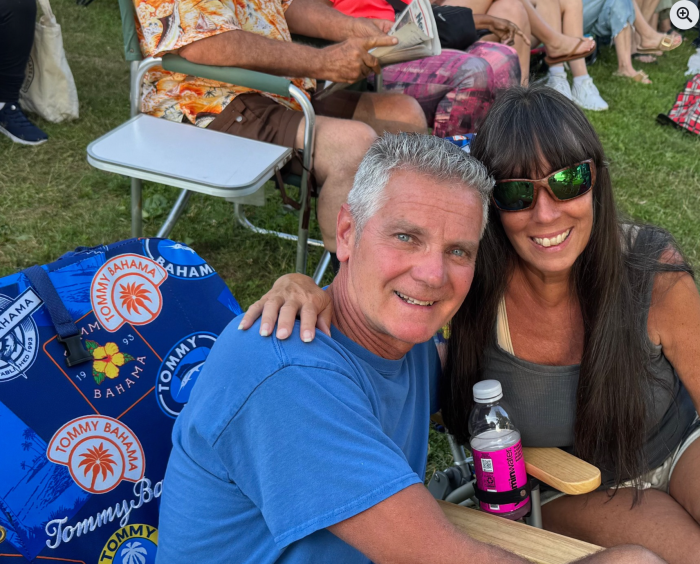Downtown project list takes shape

Ten million dollars? Not exactly chump change, but even in the context of a narrowly bounded area of a hamlet, it can only be classified as seed money.
Or, in the jargon of planners, the money will “leverage public investment for private development.”
And it’s not even $10 million anymore. The grant by New York State to fund Hicksville’s Downtown Revitalization Initiative (DRI) is really closer to $9.7 million. That’s because the planning process, which began in September, has taken a $300,000 bite from the gift.
The fifth meeting of the DRI’s Local Planning Committee (LPC) was held on Feb. 15 at the Hicksville Community Center, and members reduced what had been a long wish list of ideas into a manageable number of viable projects.
What began as vague visioning is beginning to take shape and will, members and stakeholders hope, transform the downtown.
LPC Co-Chair Dave Kapell told Anton Media Group that on March 15, the committee will meet for the last time and submit what state representative Dave Ashton called “the strategic investment plan” to the state for review and approval.
The DRI process works quickly in terms of renewal activities; it looks at a timetable of 18 to 24 months for planning, review, bids and completion. By this next time year, bids will have been accepted and construction begun.
In the meantime, the public can weigh in for the last time during a public forum on Feb. 26 at 7 p.m. at the Community Center.

Focus On The Station
The Hicksville Long Island Rail Road station, the busiest in the system outside the five boroughs, is the focus of much of the planning and visioning. It is currently undergoing a $121 million renovation by the MTA—no doubt a factor in Hicksville beating out other Long Island municipalities for the DRI grant.
For Erik Wood of design consultants HKS, a major aim of the planning was to “decongest the center,” the area immediately surrounding the station.
Much of it consists of surface parking lots, necessary but aesthetically dubious and contributing little or nothing to the tax base and economic health.
“The open space is underbuilt and underwhelming,” Wood pronounced as the slide of the rendering of the proposed series of plazas opposite the station flashed on the screen.
“We believe—based on our experiences in other places and other downtowns all across the country—that once investment in the open space occurs, you begin to increase the value or perceived value of the adjacent properties,” Wood observed. “That’s because the foot traffic that comes through Hicksville right now—that purchasing power is not being captured.”
Ashton said the state, in its DRI decisions, looks for projects that are ready to be built, are cost-effective, meet state and local goals and will have a “catalytic effect” on the surrounding area.
“As an aside, I’m very pleasantly surprised at the work that’s being done by HKS,” Ashton said of the consultants. “I was expecting great work from them, but this process wasn’t really designed to be a full urban design exercise. They came out and observed what was here and came up with smart, interesting ideas.”

Projects In Question
Among the projects the LPC reviewed and discussed:
- New LIRR Station Entry Drive: Corner of W. John Street and Wyckoff Place. Involves a complicated redesign and rerouting of the area to decongest traffic and create safe walking and commuter drop-off areas. The most distinctive feature will be a protective canopy. DRI funding expectation: $4.3 million.
- New Station Plaza: Adjacent to the Entry Drive. Located at Newbridge Road and Wyckoff Street north of the railroad and south of West Barclay Street. Aim is to decongest the area and create a safe and public space attractive to commuters and residents. DRI funding: $3 million.
- Festival Plaza: Create a new open space north of the LIRR tracks between Newbridge Road and Jerusalem Avenue. Will support seasonal, temporary activities (farmers’ markets, musical entertainment, etc.) that will draw visitors. DRI funding: $3.2 million.
- 99 Hicksville Station Plaza. Private developer proposes 200 apartments above retail spaces, along with enclosed parking. On Newbridge Road and Duffy Avenue extending along Nelson Avenue. Private investment of $40-45 million, with investor seeking $1.5 million in DRI funding.
There would also be a $75,000 grant to Trinity Lutheran Church and School Day Care Facility for an expansion plan at its West Nicholai Street location, as well as a $600,000 small business development fund to promote and support small operations in the area.

Members Have Questions
LPC members Rebecca Alesia and Anthony Macagnone, both Town of Oyster Bay councilmembers, questioned the cost of the plazas in the context of the grant.
“Seven-tenths of the money will be spent on just two plazas,” Alesia observed. “I’m not grandstanding (as applause broke out)…If someone’s not a commuter, will [the plazas] really benefit them?”
Macagnone wondered if the public spaces would see limited uses, maybe confined to the warm months.
The idea, said James McCaffrey, the Town of Oyster Bay’s deputy commissioner for economic development and a liaison from the town to the LPC, is “that you’re going to build the infrastructure for the private development to come in. A private developer is not going to create [the plazas], but if we [did], then they can build around it, and [as the property] value [goes up], they’ll want to be here.”
Wood said that the plazas will have high quality construction. He reminded attendees that “The DRI program is not going to complete everything. Part of what the strategy is here is, how do we piece together the different pots of money in order to jump-start the [building] process?”
Addressing Alesia’s questions, Wood noted that the plazas “may not be the thing that seems to immediately address the concerns of residents, but certainly this is about the conflict…that has underscored continually about the commuters and the pedestrians who are trying to get across [the streets]. Once you resolve that, a lot of things will start to flow more easily.”
Alesia praised the 99 Hicksville Station Plaza proposal, but asked, “If we give them $1.5 million, what is the guarantee that the project gets done?”
McCaffrey replied, “The state will take care of that. They are doing the vetting for us.”
LPC member Phil Heckler said the mixed-use project “restores property to the tax rolls and fulfills the need for housing.” But he suggested that the $1.5 million contribution be lowered.
McCaffrey argued that the contribution will help the developer, and will put money back into the community.
Summed up McCaffrey, “Once the private sector understands that there’s a commitment by the town to make something happen, they will actually start to step up.”
The next step the town has to take, McCaffrey observed, was changing the zoning to enable mixed use in the downtown.
He added, “We’re planting the seed, and [private developers] actually will reap the benefits from it. As a result, we can tell them, you pay for the road, you pay for the sidewalk, you pay for the lighting.”
Both McCaffrey and Kapell said that the DRI grant, after its funds are expended, will open up more grant and funding opportunities for the revitalization of the downtown.
The People Speak
Marjorie Telasco thought that Broadway needed to be expanded, drawing murmurs of incredulity from the crowd.
“More lanes would alleviate traffic,” she told Anton Media Group. “Also, all day the trucks stop and take up one lane when they make deliveries. It’s very dangerous.”
Telasco loved the idea of the Entry Plaza. “It looked so beautiful,” she said of the rendering.
Joel Berse, longtime Hicksville businessman with a long list of current and former civic associations, said he lived within 100 yards of the train station.
He fretted about the size of the crowd, stating, “I’m wondering from the things that I heard from the people in the community if the interest is waning and if some of the problems we’ve had before in planning things is coming up again.”
Berse was skeptical of the layout and traffic flow proposals, wondering what would happen “when the LIRR service is interrupted and they close down half the station for the buses? Those things are real genuine concerns that are not going away no matter how pretty they make something.”
Dev Ratnam said he had bought properties in the downtown area and made a comparison of Hicksville’s downtown with the “beautiful area” around Farmingdale’s train station, which he had visited recently.
“There is no talk about housing,” he said of the presentations. “You have to attract people from Manhattan…upscale youth, with housing and entertainment. I don’t see that emphasized. Farmingdale has it. [It’s] not here.”
LPC Co-Chair Greg Carman Jr. hails from Farmingdale and stated that “it took 10 years from the time they talked about creating a visioning process to seeing it come to fruition. And Farmingdale did not have the state grant and the opportunity for seed money.”
Carman believed that the things Ratnam mentioned would be part of Hicksville’s downtown future.
George Sahaidachny was impressed by the proposals, but said his biggest problem was the traffic. He reeled off the names of nearby streets—Routes 106 (Newbridge Route) and 107 (Broadway), Jerusalem, West John Street, Duffy Avenue,
“We are congested already,” he observed. “And I understand that we’re going to have walkways and we’re going to make Kennedy Park bigger. But where is the traffic going? I would love for this [project] to happen. But are you going to divert Broadway [traffic] somewhere else? Are you going to divert Newbridge Road?”
Sahaidachny said he grew up in Hicksville and remembered what the hamlet was like. He objected the constant comparisons to Farmingdale and other villages that had “real” downtowns and thriving transit-oriented development. They had not suffered the fate of Hicksville, he claimed.
“They didn’t have the state come in and just level parts of Hicksville,” he said, of the 1960s widening of Routes 106 and 107. “Now you are left with the remnants of destruction, and [the hamlet] has been built piecemeal.”
Sahaidachny included Old Country Road in the mix of routes that would be affected by the DRI plans.
Final Words
Town of Oyster Bay Supervisor Joseph Saladino said, “This is a great opportunity to solve the problems, including the problem of traffic.”
He noted that the grant meant that the taxpayers did not have to pay for the improvements and vowed to continue “to make sure we get our fair share from the state.”
He added, “[The DRI] is a process. It’s not a one-and-done. So your input is very much appreciated.”
Saladino assured attendees that his administration and LPC members were aware of the problems and their concerns.
“The questions you are asking—we’re dealing with them each and every day, whether you’re hearing it at the particular meeting that you’re attending,” he said. “So as we go forward there’ll be many stages. Your input is highly needed and greatly appreciated, and we’re listening to the community.”
Saladino acknowledged that the hamlet had seen its share of disappointments over planned developments over the decades.
“Now, we have a state mandate to make sure it happens and the seed money to get this started,” he said. “We’ll get something accomplished that addresses all those issues as well as greatly changes the look and feel without destroying what has always made Hicksville special.”
Former longtime Hicksville Chamber of Commerce president and LPC member Lionel Chitty was asked by Anton Media Group if the DRI proposals dovetail with the visioning and planning of revitalizing downtown Hicksville that he’s been involved with over the past decade.
”It’s in line with the broader portions of what we were looking at,” he replied. “Safe streets, a community area, taking care of some of the traffic and definitely the parking issues.”
He added, “We’re using this as a catalyst for the right projects so we can get the right people to come in. Developers are lined up. They just want to see that it’s real.”


































